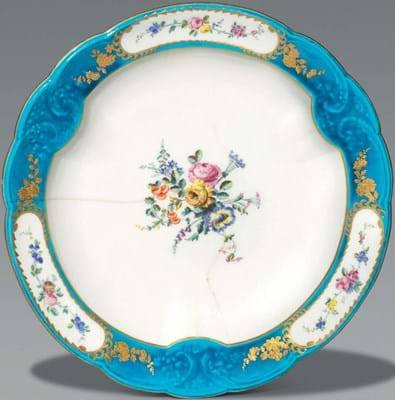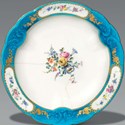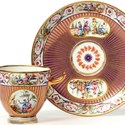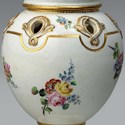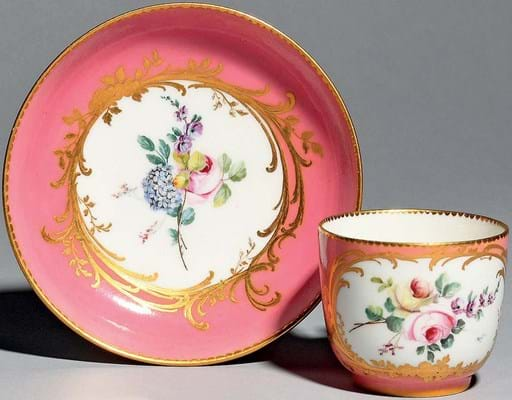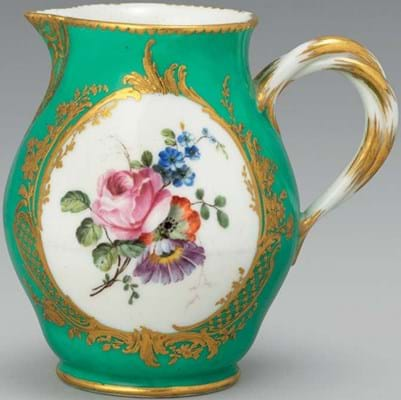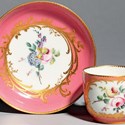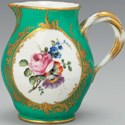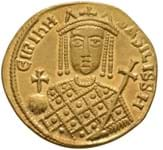Her collecting passions were many (her Georgian and Victorian mourning jewellery and Valentines cards were sold last September) but she was best known as a connoisseur of French porcelain. Her enthusiasm for Vincennes and Sèvres was fired while working at the Victoria and Albert Museum in the 1960s.
The purchase of her first piece in July 1970 began a collecting odyssey that would last almost five decades. Her last purchase in June 2018 brought the collection close to 800 pieces. It made for the largest sale of its type for a generation when offered by Woolley & Wallis (25% buyers premium) in Salisbury on February 4.
Home comforts
Displayed at home by ground colour and pattern, the vast collection placed relatively modest objects side-by-side with those made for blue-blood patrons at a time when porcelain was one of the most prized commodities.
Perhaps the most famous of these is the Roman Louis XV service made at Vincennes in the mid-1750s for regular use at Versailles. The first 120 pieces, delivered at the end of 1753, debuted the rich turquoise ground colour known as bleu celeste, as created for the project by chemist Jean Hellot (1685-1766).
Most of the service (ultimately numbering 1735 pieces) remains in Versailles and with the Duke of Buccleuch at Boughton House, Northamptonshire. However pieces do come to market – including the large oval dish sold for £70,000 at Wellers in Guildford back in 2014.
Factory records detail 28 serving plates (plat d’entrées) delivered among the third tranche of the service, on December 31, 1755, each at a cost of 240 livres. It is likely that the 12½in (32cm) dish in Howard’s collection is one of those.
Like most pieces of ‘golden age’ Sèvres it is comprehensively marked. As well as the typical ‘interlaced’ Ls, this piece carries the date letter B for 1754-55 and the painter’s mark for Pierre-Antoine Méreaud.
The dish was not in good condition (a section was broken and repaired with rivets) but it had been worth every penny of the £13 Howard had paid for it at a shop in Hungerford in 1982. It sold at the top end of expectations for £25,000 to a UK dealer.
From the beginning, the Vincennes-Sèvres project enjoyed a privileged status as manufacture royale. The cost of maintaining a porcelain factory on the outskirts of Paris was said to be four times its income. It didn’t matter when national pride was at stake, and the monarch both financier and primary client.
Madame du Barry
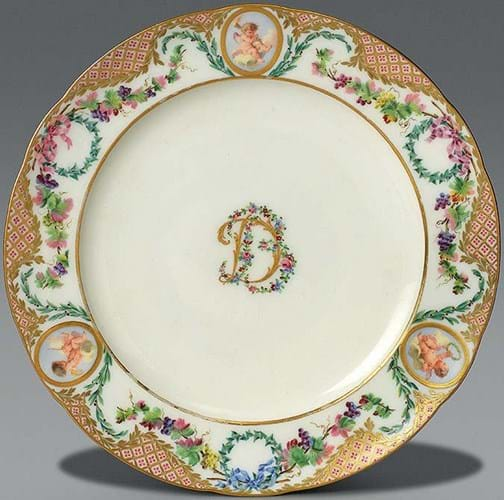
A Sèvres plate c.1770, decorated with a monogram of the gilt letter D and the letter B in flowers for Madame du Barry, £12,000 at Woolley & Wallis.
Sold for £12,000 (estimate £5000-8000) to the French trade was a plate c.1770, decorated with a monogram of the gilt letter D and the letter B in flowers for Madame du Barry (1743-93).
Before she met her end during the Reign of Terror, Louis XV’s maîtresse-en-titre received four or more Sèvres services with others left unfinished. This, speculated David Peters in his seven-volume Sèvres Plates and Services of the 18th Century, was a rare ‘sample’ from one of those unfinished services. Purchased from Warminster dealer Michael Upsall on August 1, 1985, for around £500, it was Judith Howard’s 40th birthday present – to herself.
Ice cups were a favourite form of Howard’s and there were many in the sale. The most desirable was from the service known as Petit Vases et Guirlandes, made for Madame du Barry c.1770-71 and probably intended for use at the Château de Louveciennes, which the king had given her as a gift in 1769. The service included 28 of these tasses à glace at a cost of 24 livres each. This one sold for £2400.
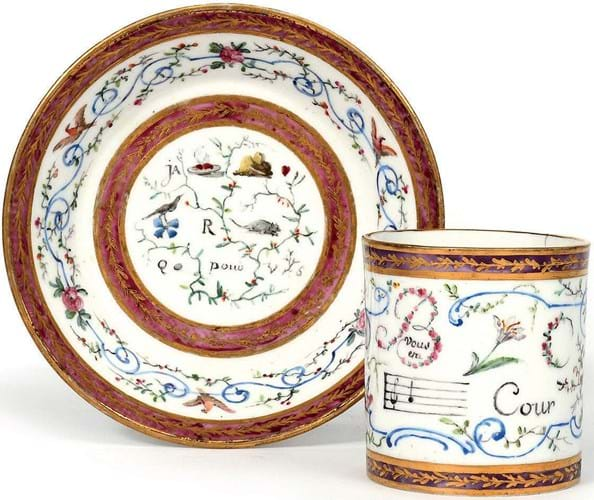
A Sèvres acrostic or puzzle can and saucer (gobelet litron et soucoupe), 1788, painted by Denis Levé with a complicated acrostic message of love, £3500 at Woolley & Wallis.
Known royal service
Also from a known royal service were two lobed triangular-form stands (plateaux Bouret) from the Attribus et groseilles service. The original service, painted with vignettes of musical and agricultural trophies, appears to have been ordered in 1763, but it is likely that these stands were among the six ordered to match on June 13, 1772, by which time the decoration might have appeared a little dated.
Bought as a pair from Robert McPherson in 1989 for £450, they were offered as consecutive lots selling at £6500 and £1800 (for the example with condition issues) to the French trade.
The Sèvres factory was a key source of royal and diplomatic gifts. A bleu celeste plate from the Comte Lascaris service c.1771 sold at £8500 (estimate £1000-2000). It marks the union of Louis XV’s grandson (later Louis XVIII) and Marie-Josephine-Louise de Savoie, daughter of the King of Sardinia, with this service presented to his foreign minister on March 25, 1771.
A plate dated 1761 painted by François Binet had been purchased for a song at Shepton Mallet in 2001. It was probably from the service given to Duchess Gertrude, the wife of John Russell, 4th Duke of Bedford, the British ambassador to France, as treaties were negotiated to end the Seven Years War in 1763. The majority of the service is still at Woburn Abbey. This plate with a restuck rim chip sold at £2600.
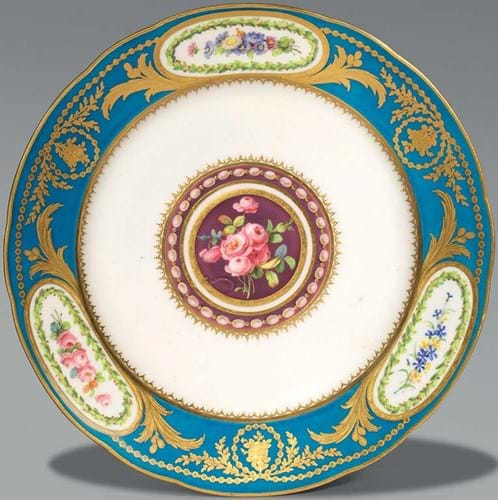
A Sèvres plate painted on a bleu celeste ground by Edmé-François Bouillat, 1785, from the Ferdinand Service gifted to Karl Anton Joseph Johann Stanislaus, Archduke of Austria and Viceroy of Lombardy, older brother of Marie-Antoinette, by Louis XVI, £7000 at Woolley & Wallis.
Buying on a budget
Howard, who once won a BBC competition to find the nation’s thriftiest couple during the days of the three-day week, generally bought on a budget. The £1800 she spent at the Masterpiece fair in 2018 on a miniature 1783 coffee can and saucer painted by Marie-Jean-Barbe Bunel was, discounting inflation, among her biggest single outlays. This, her last ever purchase, resold here at £550.
Instead, she was able to use her intimate knowledge of Sèvres ground colours, decorators, patterns and shapes to find good pieces in unexpected places. There was the occasional score. While it wasn’t included in the sale, her junk shop buys included a sucrier from the Empress Josephine Egyptian Service c.1810-12.
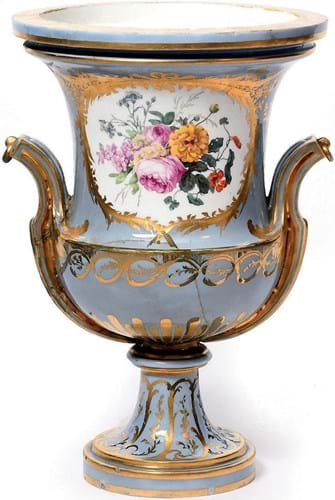
A Sèvres campana vase, 1773, painted with panels of flower and fruit by Pierre-Nicolas Pithou l’aîné on a rare gris d’agate or bleu d’agate ground, damages and probably lacking a cover, 11in (28cm), £3800 at Woolley & Wallis.
Among the more unusual pieces offered here (bought in Hungerford in 1986) was an 11in (28cm) campana vase, 1773, painted with panels of flower and fruit by Pierre-Nicolas Pithou l’aîné on an unusual pale blue ground.
It was in poor condition (broken and missing a cover) but the form is unrecorded and the unusual ground colour probably that referred to in the order books as gris d’agate or bleu d’agate. Louis XV bought a pair of vases of this description in 1775 at a cost of 600 livres. It sold at £3800 (estimate £100-200) to a French private collector.
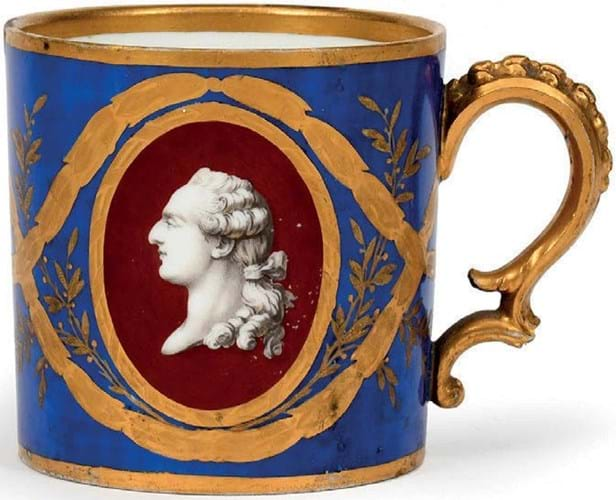
A rare Sèvres portrait can (gobelet litron) c.1775, painted probably by Nicolas-Pierre Pithou jeune with grisaille portraits of Louis XVI and Marie Antoinette against a brick red ground, some retouching, £3200 at Woolley & Wallis.
Also performing well were a series of rare coffee cans (gobelets litron). One, made c.1775 and painted by Nicolas-Pierre Pithou jeune with grisaille portraits of Louis XVI and Marie Antoinette against a brick red ground, took £3200 from the French trade.
Similar to others in the royal collection were cans decorated by LG (Louis Antoine Le Grand or Etienne-Henri Le Guay) with gilt birds and scrollwork reserved on a bleu nouveau ground. One, bought by Howard at Sotheby’s Billinghurst in 1989, took £2600 while a (slightly larger) model with a filled chip and crack, bought from E&H Manners in 1988 for £480, took £550. Both went to private UK buyers.
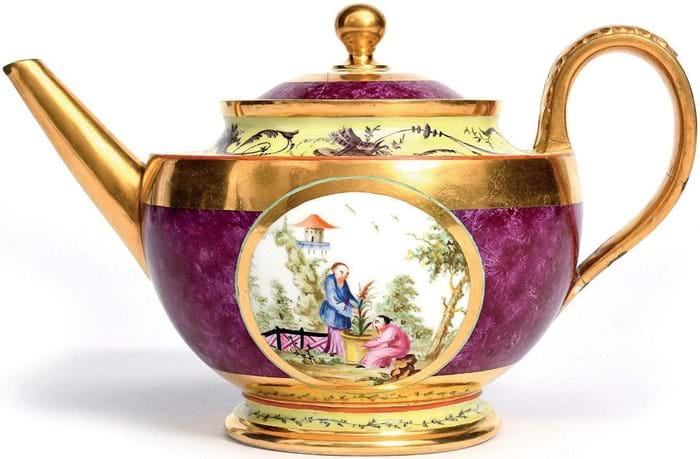
A Sèvres Republican teapot and cover c.1794-1800, painted by Jean-Jacques Dieu with chinoiserie figure scenes on a puce faux porphyry ground, repairs to the handle and cover, £2800 at Woolley & Wallis.
There were relatively few neoclassical pieces from the post-Revolutionary era when Sèvres took new technical and artistic directions under director Alexandre Broigniart (1770-1847).
However, a teapot and cover c.1794-1800, painted by Jean-Jacques Dieu with chinoiserie vignettes on a puce faux porphyry ground, took £2800 (£300-500) from an agent bidding for a collector. With repairs to the handle and cover, it had been bought from John Whitehead.
Accessible way to start a collection
Modest 18th century tea wares are a more accessible way to start a collection. Howard amusingly referred to these as ‘cooking Sèvres’ – pieces from the stock services decorated with relatively simple patterns that (so the factory archives tell us) were sold at much lower prices to members of the merchant class or for everyday use by ‘the staff’.
Similarly she owned a good number of what used to be called ‘study’ pieces – those with only a modest commercial value because of damage. In short, plenty was available from £100-400.
In this aspect of the sale the National Trust’s Waddesdon Manor was among the buyers. Home to many magnificent objects from the French ancien regime, it is seemingly light on pieces that can be made available for students to handle.
The sale total was almost exactly £300,000, above the pre-sale hopes of up to £250,000 and proof that, with its international reach, the market for French porcelain is more active than others in the ceramics field. Some 350 bidders were active at the sale, with more than 95% of the 400 lots sold to around 120 buyers from the UK, US, Canada, France, Italy, Belgium, Germany, Switzerland, Russia and Japan.
Luxury, it seems, is never out of fashion.


